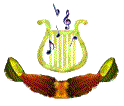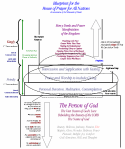 School
of Intercessory Worship / Tabernacle of David School
of Intercessory Worship / Tabernacle of David
 An ongoing
collection of downloads and study notes used
in conjunction with
training in Intercessory
Worship. An ongoing
collection of downloads and study notes used
in conjunction with
training in Intercessory
Worship.
Revelation 5:6-8
Now when He had taken the scroll, the four living creatures and the
twenty-four elders fell down before the Lamb, each having a harp, and golden
bowls full of incense, which are the prayers of the saints.
What is Intercessory
Worship?
 Doing worship and intercession on earth as it is done
in heaven (Matt 6:9-13) Doing worship and intercession on earth as it is done
in heaven (Matt 6:9-13)
A picture of worship in Spirit and in truth (John 4:24)
Coming before God with both the “harp” and the “bowl”
The “covering” that existed in the prophetic spirit of
the Tabernacle of David
A more “natural” approach to doing both praise and
worship
It is the means by which God can make us “joyful” in
His house of prayer (Is 56:5-8)
It is one aspect of the Tabernacle of David that God intends to restore (Amos 9:11-12; Acts
15:16-17)
What's
the Big Picture?
 There
is a global worship movement that will fill the earth
in the generation the Lord returns (Is 62) There
is a global worship movement that will fill the earth
in the generation the Lord returns (Is 62)
The Holy Spirit is going to birth night and day prayer
and worship for a release of justice (Luke 18:1-8)
The primary identity of the people of God in terms of
ROLE will be as the House of Prayer (Matt 21:13)
The Lord is going to release an anointing of joy in
prayer that is patterned on a heavenly model (Is 56)
King David had a vision of this heavenly model... and
instituted it in the ministry of his tabernacle (1 Chr
15)
What makes Intercessory
Worship different than other prayer formats?
 We
use Scriptural prayer (the Apostolic Prayers of
Paul, Peter, John, and Jesus) We
use Scriptural prayer (the Apostolic Prayers of
Paul, Peter, John, and Jesus)
We vocalize Scriptural prayer (versus praying inward
or quietly)
We vocalize Scriptural prayer with song (versus with
words)
We vocalize Scriptural prayer with song corporately
and together (versus by ourselves)
What do these help accomplish?
 They
engage people spiritually during prayer They
engage people spiritually during prayer
They provide a framework for true united prayer
They allow people to “feel” God (one aspect of being
filled with the Spirit) during prayer
They allow our hearts and spirits to be renewed and
touched by God as we pray
Several components are combined in Intercessory
Worship:
 Praise & Adoration (with KNOWN
worship songs) Praise & Adoration (with KNOWN
worship songs)
Singing spontaneously
by one of three
possible means
-- Singing spontaneously the Psalms of David
-- Singing spontaneously the
Hymns of Revelation
-- Singing with or from our spirits (1 Cor. 14:14-16)
Antiphonal (responsive) singing of Scriptural Prayers
-- Apostolic Prayers
of Paul, Peter, John, and His Majesty
-- Scriptural passages that are prayers (versus
Scripture about prayer)
We are
developing 3 different formats for intercessory worship
cycles:
 Apostolic
Intercession Apostolic
Intercession
Antiphonal Psalmody: Hymns of Revelation, Psalms, and
Song of Solomon
Prayer-Worship w/ Traditional Hymns of the Church
|
 School
of Intercessory Worship / Tabernacle of David
School
of Intercessory Worship / Tabernacle of David

